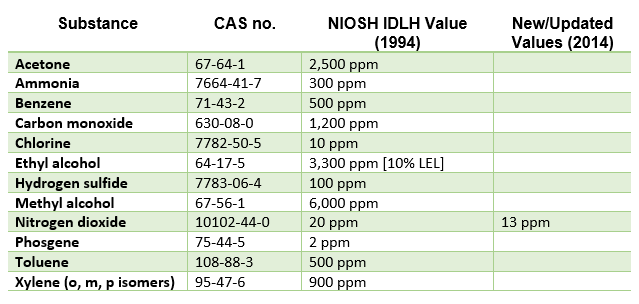
Blog Post #13 – In this post to The Confined Space Training Blog, we will examine the fifth and final category listed in the Federal OSHA definition for a hazardous atmosphere in a confined space, which is an atmosphere that is Immediately Dangerous to Life or Health, or IDLH.
What Does IDLH Mean?
IDLH stands for “Immediately dangerous to life or health”. This term is defined in the Federal OSHA confined space standards as “any condition that would interfere with an individual’s ability to escape unaided from a permit space and that poses a threat to life, or that would cause irreversible adverse health effects.” OSHA goes on to qualify their definition of IDLH by adding that certain substances, like hydrogen fluoride gas and cadmium vapor, can cause immediate, temporary effects that may not require medical intervention, even if they are severe. However, after exposure to high levels of these substances when the affected individual may appear to have fully recovered from the initial symptoms, these diminished effects are followed by a sudden and potentially fatal collapse within twelve to seventy-two hours of over-exposure. Therefore, materials with these characteristics present in hazardous amounts are also categorized as immediately hazardous to life or health (IDLH) by OSHA.
For further context, the term IDLH is also found in the Federal OSHA respiratory protection standard at 1910.134, where it is defined as “an oxygen deficient atmosphere, or, any atmosphere of unknown composition.” And in the Federal OSHA HazWoper standard (1910.120), IDLH is defined as “an atmospheric concentration of any toxic, corrosive or asphyxiant substance that poses an immediate threat to life or would cause irreversible or delayed adverse health effects or would interfere with an individual’s ability to escape from a dangerous atmosphere.”
NIOSH IDLH Values
Federal OSHA does not quantify IDLH levels or concentrations of specific airborne toxic substances in 1910 Subpart Z like they do for their permissible exposure limits (or PELs). However, other agencies and groups do list IDLH values for specific chemicals; the primary one in the USA being NIOSH, aka the National Institute for Occupational Safety and Health. NIOSH defines IDLH as an atmospheric concentration of a specific airborne substance “that poses a threat of exposure to airborne contaminants when that exposure is likely to cause death or immediate or delayed permanent adverse health effects or prevent escape from such an environment.”
NIOSH considered two factors while determining their IDLH limits. Firstly, they wanted to ensure workers would be able to exit the area where they came into contact with dangerous chemicals without enduring lasting harm to their health. And secondly, they wanted workers to be able to escape without experiencing severe eye or respiratory tract irritation (or other conditions) that could hinder their ability to evacuate.
NIOSH currently lists IDLH values for more than 380 substances. Here is a table displaying a dozen common substances and their assigned NIOSH IDLH values as originally assigned in 1994, and as updated, where applicable, in 2016.

Many of these substances listed above have a Federal OSHA PEL based on an 8-hour time-weighted average (TWA), but do not have a short-term exposure limit (STEL), which is based on a 15-minute average exposure, or a ceiling limit (C), which is based on instantaneous exposure. Therefore, in some cases brief exposures to certain substances (Carbon Monoxide being one of them) may not exceed the OSHA PEL, but could exceed the NIOSH IDLH value.
Other Types of IDLH Atmospheres
Last but not least, some of the other types of “hazardous atmospheres” discussed in the preceding blog posts could also be considered to be IDLH if present in high enough quantities. For example, an atmosphere that is oxygen deficient would certainly be classified as IDLH, as would an atmosphere containing a flammable gas or vapor at levels exceeding 10% of its LEL (or LFL); see Ethyl alcohol on the NIOSH list for one such example. And in certain cases, it could be possible that an atmosphere that is extremely hot (from steam or other heat sources) could incapacitate a person should super-heated air damage their lungs or trachea when inhaled.
Review of OSHA’s Definition of a Hazardous Atmosphere
In review, a confined space containing a hazardous atmosphere, or with a reasonable potential for a hazardous atmosphere to develop, is considered a permit-required confined space. And OSHA lists five different categories of potentially hazardous atmospheres inside a confined space.
The first one is when any flammable gas, vapor, or mist is present in a quantity greater than 10% of its LFL; Next is when airborne combustible dust is present at quantity greater than, or equal to, its LFL; A hazardous atmosphere also exists when the atmospheric oxygen concentration drops below 19.5%, or rises above 23.5%; as well as when a toxic substance is present in a quantity greater than it’s permissible exposure limit, or PEL. Finally, the atmosphere in a confined space is classified as hazardous whenever it is determined to be immediately dangerous to life or health, or IDLH.
Please provide your feedback and/or questions about this blog post on IDLH atmospheres, or about any of the other type(s) of hazardous atmospheres, in the comments section below. Then be sure to come back later and read our next blog post (#14), where we will discuss engulfment hazards in confined spaces. And as always, I ask that you take a moment to spread the word about our confined space training blog by sharing a link to this post with others in your network so they can benefit from this information. Thanks – Curtis
Thank you for some great info. Its not my job today . But its good to know there are some sources of info. I am in security now a days. Safety is part of my job. I have a post at a chemical plant. I also wonder about safety , when I am site. Thank you all for all you do.
Thank you Steven